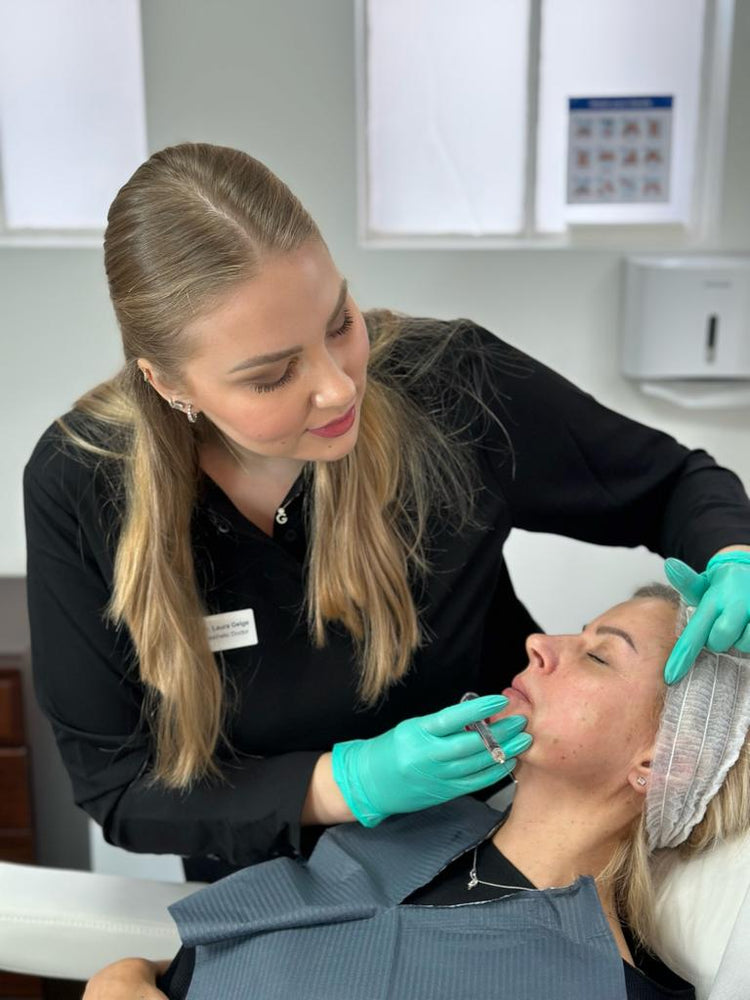Risks Associated with Marionette Line Fillers
Marionette lines, those vertical creases that run from the corners of the mouth to the chin, can be a common concern for individuals seeking smoother facial contours. While dermal fillers offer a popular solution for minimizing their appearance, it’s crucial to understand the potential risks and side effects associated with this treatment, particularly in Kingston Upon Thames.
Infection
As with any medical procedure, marionette line fillers carry certain risks, including infection. Infection can occur if bacteria enter the injection site, leading to redness, swelling, pain, and even abscess formation. Maintaining good hygiene before and after the procedure, as well as following your practitioner’s post-treatment instructions, is essential for minimizing this risk.
Other potential complications include bruising, swelling, and temporary asymmetry. In rare cases, more serious side effects like allergic reactions or vascular occlusion (blockage of blood vessels) can occur. Choosing a qualified and experienced injector who adheres to strict sterilization protocols is crucial for reducing the likelihood of these adverse events.
Allergic Reactions
Allergic reactions are another risk associated with marionette line fillers. Although rare, individuals may experience an allergic response to the filler material, leading to symptoms such as itching, redness, swelling, or hives. It’s important to inform your practitioner about any known allergies or sensitivities before undergoing treatment. In cases of severe allergic reaction, immediate medical attention is necessary.
Lumpy or Uneven Results
One potential risk with marionette line fillers is the possibility of achieving lumpy or uneven results. This can occur if the filler is not injected correctly or evenly distributed. The skill and experience of the practitioner are crucial in achieving natural-looking, smooth outcomes.
It’s important to discuss your expectations with your injector beforehand and to ask about their experience in treating marionette lines specifically. Choosing a qualified professional who uses high-quality fillers and meticulous injection techniques can help minimize the risk of uneven results.
Asymmetry
Marionette line fillers offer a popular solution for smoothing vertical creases from the corners of the mouth to the chin. However, like any medical procedure, there are potential risks and side effects to consider.
Infection is a concern if bacteria enter the injection site, leading to redness, swelling, pain, and potentially abscess formation. Maintaining good hygiene and following post-treatment instructions is vital for minimizing this risk.
Bruising, swelling, and temporary asymmetry are common side effects that typically subside over time.
In rare instances, more serious complications can occur, such as allergic reactions or vascular occlusion (blockage of blood vessels). It’s essential to choose a qualified injector who adheres to strict sterilization protocols to minimize these risks.

Allergic reactions, although uncommon, are possible and can manifest as itching, redness, swelling, or hives. Disclose any known allergies to your practitioner before treatment.
Achieving natural-looking results is key. Lumpy or uneven outcomes can occur if the filler isn’t injected correctly or distributed evenly. Discuss your expectations with your injector, and ensure they have experience treating marionette lines specifically.
Vascular Compromise
Vascular compromise is a serious potential risk associated with marionette line fillers. This occurs when blood flow to the treated area is disrupted, which can lead to tissue damage or necrosis (tissue death).
The risk of vascular compromise is higher when fillers are injected near blood vessels. It’s crucial for injectors to have extensive knowledge of facial anatomy and to carefully avoid injecting into or near major vessels during the procedure.
Signs of vascular compromise may include pain, redness, swelling, discoloration, or numbness in the treated area. If you experience any of these symptoms after receiving marionette line fillers, seek immediate medical attention.
Migraines and Headaches
Marionette line fillers offer a popular solution for smoothing vertical creases from the corners of the mouth to the chin. However, like any medical procedure, there are potential risks and side effects to consider.
Infection is a concern if bacteria enter the injection site, leading to redness, swelling, pain, and potentially abscess formation. Maintaining good hygiene and following post-treatment instructions is vital for minimizing this risk.
Bruising, swelling, and temporary asymmetry are common side effects that typically subside over time.
In rare instances, more serious complications can occur, such as allergic reactions or vascular occlusion (blockage of blood vessels). It’s essential to choose a qualified injector who adheres to strict sterilization protocols to minimize these risks.
Allergic reactions, although uncommon, are possible and can manifest as itching, redness, swelling, or hives. Disclose any known allergies to your practitioner before treatment.
Achieving natural-looking results is key. Lumpy or uneven outcomes can occur if the filler isn’t injected correctly or distributed evenly. Discuss your expectations with your injector, and ensure they have experience treating marionette lines specifically.
Vascular compromise is a serious potential risk associated with marionette line fillers. This occurs when blood flow to the treated area is disrupted, which can lead to tissue damage or necrosis (tissue death).
The risk of vascular compromise is higher when fillers are injected near blood vessels. It’s crucial for injectors to have extensive knowledge of facial anatomy and to carefully avoid injecting into or near major vessels during the procedure.
Signs of vascular compromise may include pain, redness, swelling, discoloration, or numbness in the treated area. If you experience any of these symptoms after receiving marionette line fillers, seek immediate medical attention.
Side Effects of Marionette Line Fillers
Marionette line fillers offer a popular solution for smoothing vertical creases from the corners of the mouth to the chin. However, like any medical procedure, there are potential risks and side effects to consider.
Bruising and Swelling
Bruising and swelling are common side effects after marionette line filler treatment.
This is a normal reaction to the injection process and typically subsides within a few days to a week. Applying cold compresses can help reduce swelling, and your practitioner may recommend arnica gel or medication to manage bruising.
Redness and Inflammation
Redness and inflammation are also common side effects of marionette line fillers.
- These reactions usually appear immediately after the procedure and gradually subside within a few days to a week.
- Keeping the treated area clean and avoiding touching it can help minimize inflammation.
- Your practitioner may advise you on the best ways to manage redness and swelling, such as applying cool compresses or using over-the-counter anti-inflammatory medications.

Pain and Discomfort
Pain and discomfort are common experiences following marionette line filler injections.
The level of pain varies from person to person and can depend on factors such as individual pain tolerance, the amount of filler used, and the practitioner’s technique.
Some individuals may experience a sharp, stinging sensation during the injection, while others feel only mild discomfort.
After the procedure, there may be some tenderness or soreness in the treated area.
Most patients find that over-the-counter pain relievers, such as ibuprofen or acetaminophen, effectively manage any discomfort.
Temporary Numbness
Temporary numbness is a common side effect of marionette line fillers. It occurs because the anesthetic used during the procedure can temporarily affect the nerve endings in the treated area.
This numbness usually subsides within a few hours to a few days after the treatment.

Changes in Skin Texture
Marionette line fillers offer a popular solution for smoothing vertical creases from the corners of the mouth to the chin. However, like any medical procedure, there are potential risks and side effects to consider.
Infection is a concern if bacteria enter the injection site, leading to redness, swelling, pain, and potentially abscess formation. Maintaining good hygiene and following post-treatment instructions is vital for minimizing this risk.
Bruising, swelling, and temporary asymmetry are common side effects that typically subside over time.
In rare instances, more serious complications can occur, such as allergic reactions or vascular occlusion (blockage of blood vessels). It’s essential to choose a qualified injector who adheres to strict sterilization protocols to minimize these risks.
Allergic reactions, although uncommon, are possible and can manifest as itching, redness, swelling, or hives. Disclose any known allergies to your practitioner before treatment.
Achieving natural-looking results is key. Lumpy or uneven outcomes can occur if the filler isn’t injected correctly or distributed evenly. Discuss your expectations with your injector, and ensure they have experience treating marionette lines specifically.
Vascular compromise is a serious potential risk associated with marionette line fillers. This occurs when blood flow to the treated area is disrupted, which can lead to tissue damage or necrosis (tissue death).
The risk of vascular compromise is higher when fillers are injected near blood vessels. It’s crucial for injectors to have extensive knowledge of facial anatomy and to carefully avoid injecting into or near major vessels during the procedure.
Signs of vascular compromise may include pain, redness, swelling, discoloration, or numbness in the treated area. If you experience any of these symptoms after receiving marionette line fillers, seek immediate medical attention.
Changes in skin texture can occur as a result of marionette line filler treatment, but these are usually temporary and subtle. The filler itself might initially cause the skin to appear slightly thicker or more textured, which tends to settle down within a few days to weeks as the body adjusts.
It’s also possible for the filler to create a smoothing effect on the skin by plumping up the area and minimizing the appearance of fine lines and wrinkles.
Long-term changes in skin texture are unlikely with appropriate filler selection and injection technique.
Book your Nasolabial Fold Filler treatment with Dr. Laura Geige at It’s Me & You Clinic today
- Cradled Clam Sex Position - July 11, 2025
- Cosmelan Depigmentation Peel Near Churt, Surrey - July 5, 2025
- Cosmelan Depigmentation Peel And Its Impact On Skin Texture In The UK - July 3, 2025
